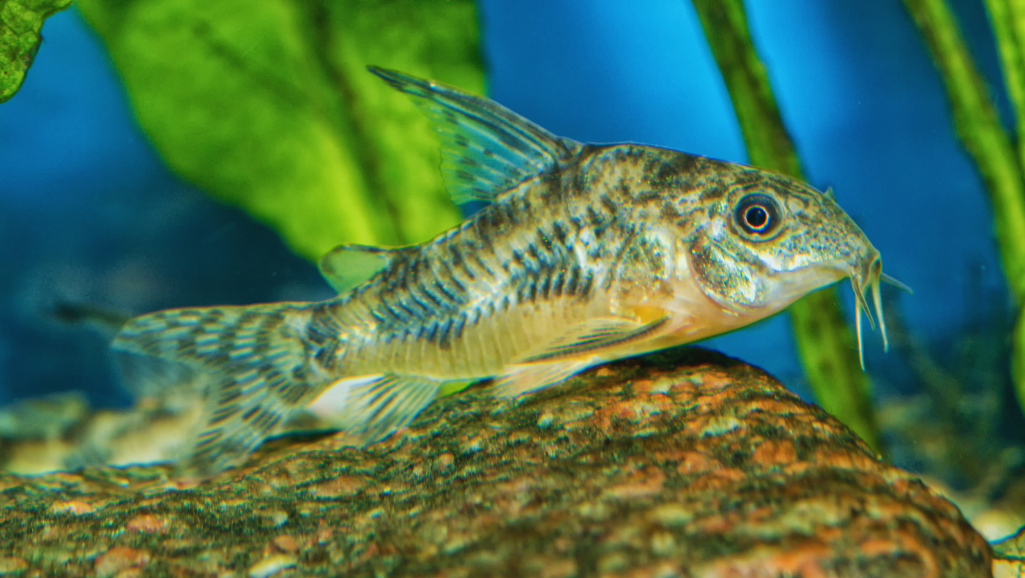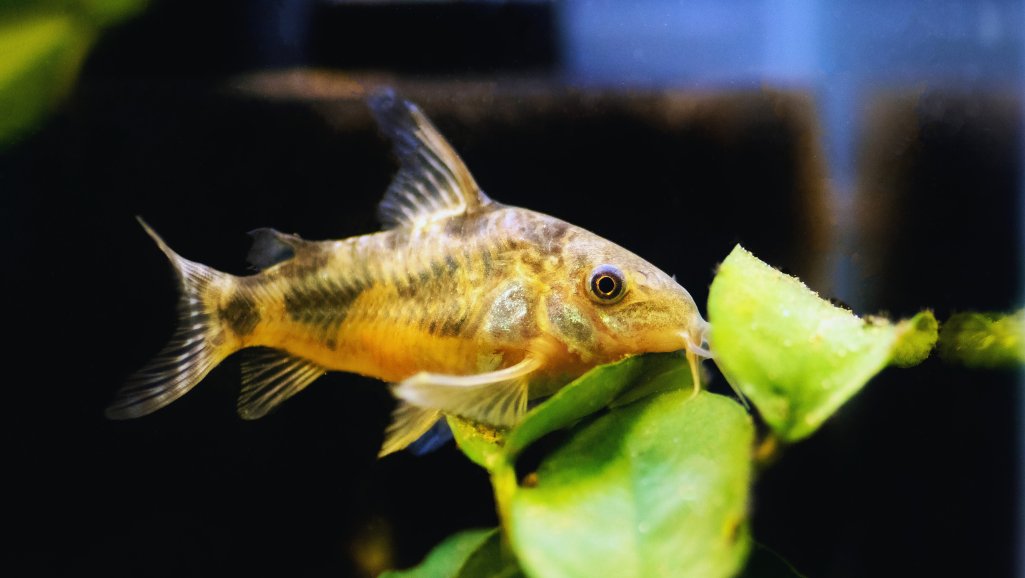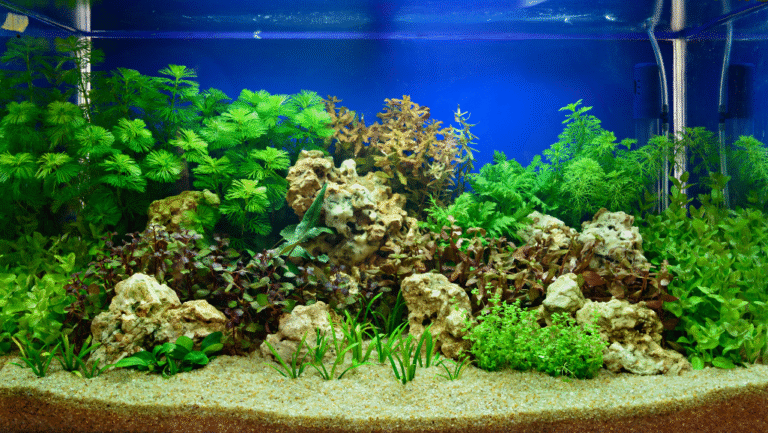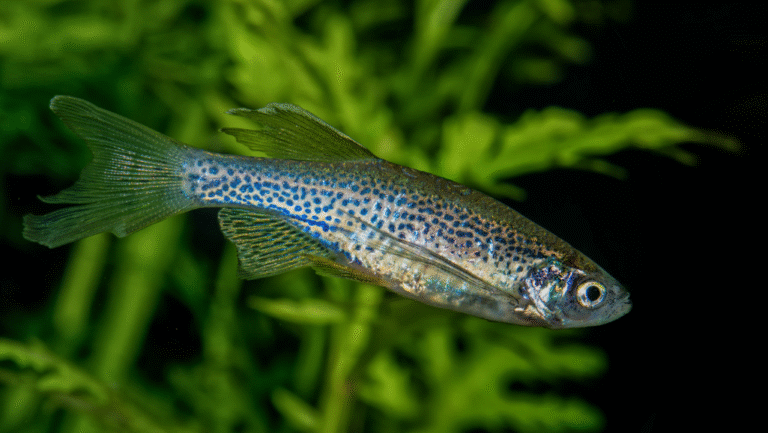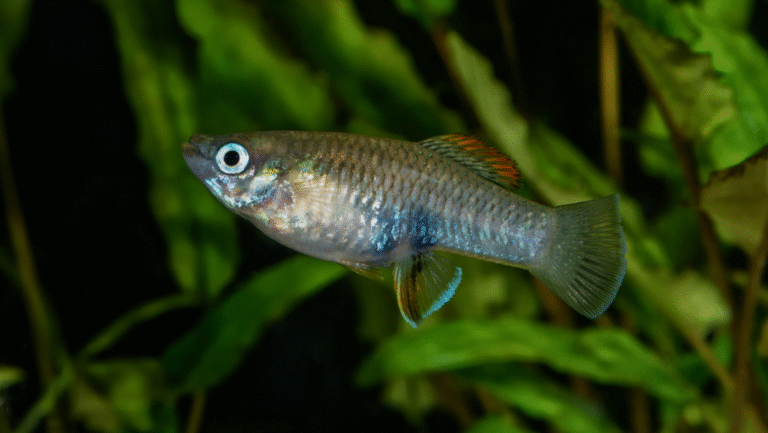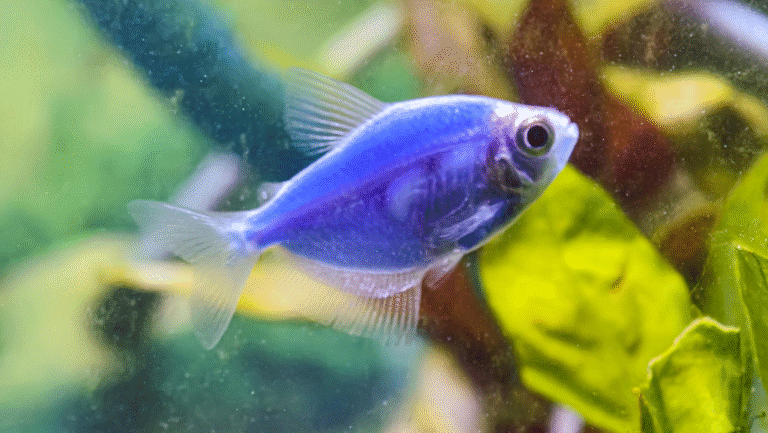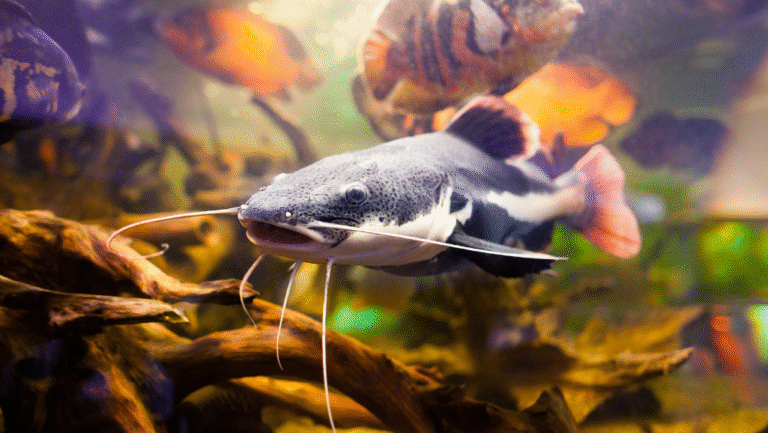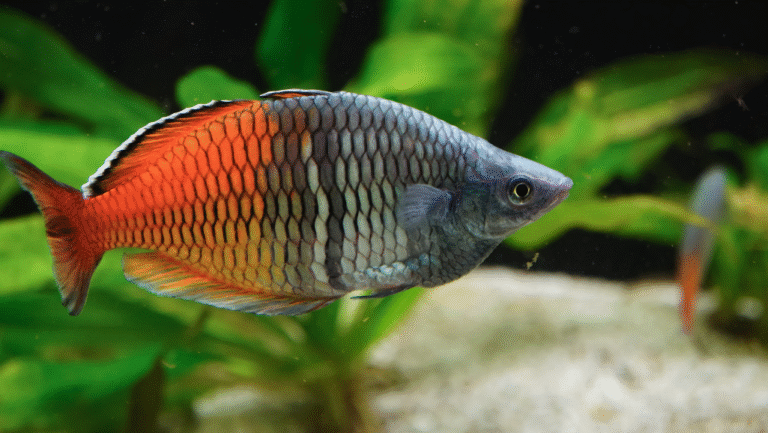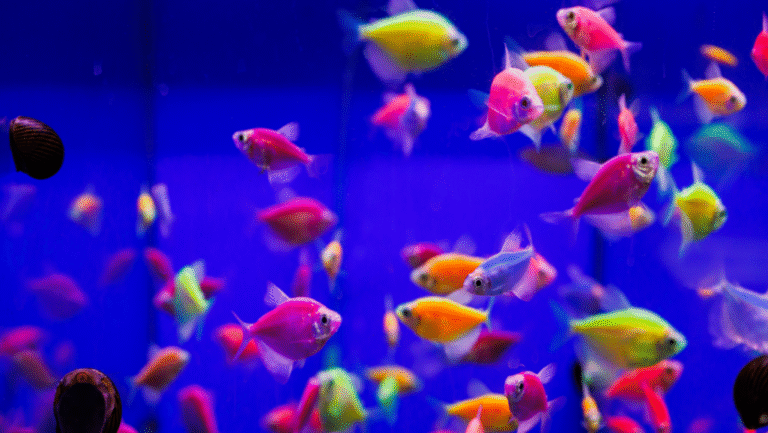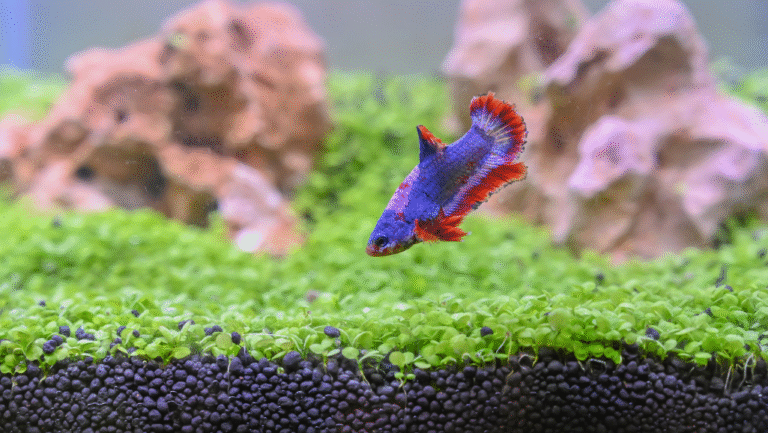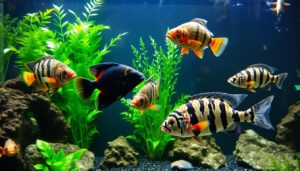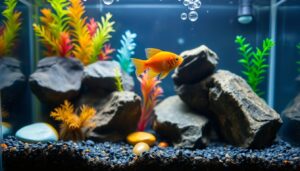Corydoras Catfish are small, armored fish that are loved by many in the tropical fishkeeping world. They are known for their peaceful nature and interesting bottom-dwelling habits. To keep them happy and healthy, it’s important to know how to care for them properly.
This guide will help you learn how to set up their habitat and meet their dietary needs. We aim to make their home in your aquarium a great place for them to thrive.
Key Takeaways
- Understand that Corydoras Catfish thrive in tanks that are 20 to 30 gallons in size, making proper tank selection one of the first steps in their care.
- Maintain water temperatures between 72°F and 78°F, and pH levels from 7.0 to 7.8, to mimic their natural tropical conditions.
- Ensure a sandy substrate to prevent harm to Corydoras’ delicate barbels, advocating for their well-being.
- Capitalize on their social and peaceful traits by selecting non-aggressive tank mates for a harmonious community aquarium.
- Feed Corydoras with a variety of nutritional options such as high-protein, sinking foods, which cater to their bottom-dwelling feeding style.
- Encourage breeding by providing the necessary conditions and diet, such as a protein-rich selection that stimulates their spawning behavior.
- Remember that a group of at least 8-12 pygmy Corydoras can bring out their natural behavior and reduce shyness among the species.
Introduction to the World of Corydoras Catfish
The world of aquatic pets is growing more interested in Corydoras catfish. These fish are among the most popular catfish species. They come from the Neotropical fishes family and have over 160 species. They are loved for being calm and having a unique armor of bony plates.
People who love aquatic pets find Corydoras catfish fascinating. They are easy to care for and fun to watch. You can choose from many types, like the Bronze Corydoras or the Panda Corydoras. They add excitement to any tank.
Corydoras can live in different environments. They like water between 72 to 78°F and pH levels from 7.0 to 8.0. This makes them a favorite among both new and experienced aquarium owners. Want to know more about keeping them in a community tank? Check out a detailed guide on aquatic pet community dynamics.
These fish can live a long time, up to 27 years in good care. Their unique breeding behavior, like the “T-position” during spawning, is also interesting.
| Species | Size (cm) | Preferred pH Level | Life Expectancy (Years) |
|---|---|---|---|
| Corydoras aeneus | 7-10 | 7.0-8.0 | Up to 27 |
| Panda Corydoras | 5 | 6.5-7.5 | 10-15 |
| Emerald Green Corydoras | 7.5 | 7.0-8.0 | 10-20 |
Corydoras catfish are a big topic among aquatic pet fans. For more information on their care, check out WebMD’s Corydoras care guide. Keeping them in your aquarium is not only beautiful but also educational.
Corydoras Catfish: The Ideal Community Aquarium Residents
Corydoras catfish are known for being peaceful community fish. They get along well with many other fish. Their small size and social nature make them great for a harmonious tank.
To set up a good home for Corydoras, it’s key to know what they need. They do best in groups of six or more. This helps them feel safe and happy in their tank.
Compatibility with Other Fish Species
Corydoras catfish are good friends with small, calm fish. They live well with Neon Tetras, Cherry Barbs, and others. But, they shouldn’t be with big, mean fish. Big fish might scare or hurt them.
Choosing fish that like calm water and are not too big helps keep the tank balanced. This makes sure everyone gets along.
Peaceful Nature and Social Behaviors
Corydoras are fun to watch because they play together. They search the bottom of the tank in a group. This shows they are happy and healthy.
| Fish Species | Compatibility Level with Corydoras | Notes |
|---|---|---|
| Platys | High | Similar size and peaceful nature |
| Cherry Barbs | High | Enjoy similar water conditions |
| Neon Tetras | High | Prefer peaceful co-inhabitants |
| Male Bettas | Medium | Only one male per tank recommended |
| Goldfish | Low | Different water temperature and quality needs |
Adding Corydoras catfish to your tank is a smart choice. They make your tank look good and feel peaceful. They help keep the tank clean and balanced, which is good for all the fish.
Optimal Tank Conditions for Corydoras
Creating the right tank setup is key for keeping Corydoras healthy. These fish do well in conditions that match their natural home. This helps reduce stress and keeps them disease-free.
Corydoras catfish are known for being calm and easy to care for. They need a specific temperature range to stay healthy. Keeping the water between 72°F and 80°F (22°C to 27°C) is crucial. Corydoras don’t like sudden changes in temperature.
Water chemistry is also very important in tropical fishkeeping. Corydoras prefer a pH between 6.5 and 7.5. Regular water tests and slow adjustments are needed to keep the pH right.
Corydoras are very sensitive to harmful chemicals like ammonia, nitrite, and nitrate. This makes a good filtration system very important.
For hardness, Corydoras like soft water, best between 3 to 10 dGH. Using water conditioners or a reverse osmosis system helps keep the water soft. This controls minerals that can harm Corydoras.
- Substrate: Fine sand or rounded gravel is best to protect Corydoras’ barbels.
- Grouping: Corydoras should always be in groups. Being alone can stress them out.
- Filtration: A high-quality filter is needed. It should handle the tank’s bioload but have a gentle flow.
By carefully managing the tank environment, fans of tropical fishkeeping can help their Corydoras thrive. This makes for a lively and healthy aquarium.
Creating a Habitat: Substrate, Plants, and Decorations
Creating the perfect aquatic pet habitat for Corydoras starts with the right substrate for Corydoras. These fish have sensitive barbels that need protection. Smooth sand or fine gravel is best, letting them forage safely. The substrate also helps mimic their natural environments.
Choosing the Right Substrate
Choosing the right substrate is key for Corydoras. Their six barbels help them find food, so a gentle substrate is needed. Smooth sand is best because it’s like their native riverbeds. It prevents barbel damage and makes the tank look great.
Importance of Live Plants and Aquascaping
Adding live aquarium plants is crucial for a real aquatic pet habitat. Plants like java fern and anubias add beauty and hiding spots. They also help keep the tank healthy by absorbing nitrates and providing oxygen. For a real transformation, check out live plants to make your tank look like their natural habitats.
Providing Hiding Spots with Caves and Rocks
Adding caves and rocks is important for Corydoras’ safety and comfort. These features mimic their natural hiding spots. They also help establish territories and support natural behavior, keeping the fish healthy and happy.
Every detail matters when setting up a home for Corydoras. From the right substrate to the placement of rocks and plants, it all counts. For more tips on keeping your tank perfect, check out aquarium water maintenance for essential care advice.
The Corydoras Diet: Foods and Feeding Practices
The health of Cory catfish depends a lot on how they eat. They need a balanced aquarium diet to do well in a home tank. It’s important to give them a variety of foods that meet their nutritional needs.
Varied Diet for Optimum Health
A varied diet is key for tropical fish nutrition. Corydoras are not just algae-eaters. They are omnivorous and need both animal and plant-based foods. High-quality sinking pellets are a good choice because they sink to the bottom of the tank.
Here are some foods Corydoras can eat:
- Live and frozen foods like brine shrimp or bloodworms for their meaty side.
- Vegetable-based foods and wafers for balanced nutrients.
- Special pellets like Hikari Sinking Carnivore Pellets, made for their specific needs.
Feeding Tips for Bottom Dwellers
Feeding Corydoras right means making sure they get food at the bottom. This can be tricky because other fish might eat it first. Here are some tips:
- Feed them at night when other fish are less active.
- Use feeding rings or special spots in the tank for food, so Corydoras know where to find it.
Consistency and monitoring are crucial to keep Corydoras healthy and avoid malnutrition.
Common Dietary Misconceptions
Corydoras are good at finding food, but they shouldn’t just eat leftovers. They need a planned diet to stay healthy and avoid common problems.
| Product | Size Options | Category |
|---|---|---|
| Hikari Micro Pellets | 22g, 45g, 1kg | For small tropical fish |
| Hikari Sinking Carnivore Pellets | 74g, 1kg | For carnivorous bottom fish |
| Hikari Algae Wafers | 20g to 1kg | For algae-eating bottom feeders |
| Hikari First Bites | 10g | For fry fish |
In summary, knowing how to feed your Corydoras properly is key to their health. A balanced aquarium diet and careful feeding practices help them live long and healthy lives. By understanding their needs and feeding them right, you can make sure they thrive in their tank.
Breeding Corydoras in Home Aquariums
To breed Cory Catfish successfully, you need to know their breeding habits and create the right conditions. This journey begins with picking the right species and setting up the breeding area carefully.
Did you know over 150 Corydoras species exist, with more than 30 available for hobbyists? To boost breeding chances, start with a group of both genders. Buying at least five fish can help ensure a mix of males and females, making reproduction more likely.
| Criteria | Parameter |
|---|---|
| Recommended Tank Size | 20 liters for albino Corydoras |
| Temperature for Breeding | 25°C |
| pH Level | Neutral |
| Water Hardness | Slightly Soft |
| Hatching Duration | Approx. 3 days |
| Optimal Fry Food | Micro-worms, dry fry food |
For breeding, a trio setup (one female and two males) is recommended. This keeps the fry safe from other fish. Also, keeping water quality high is key; methylene blue helps prevent fungal infections and keeps eggs healthy.
The fry grow fast after hatching, looking like tiny versions of their parents in a month. They need a rich diet, like micro-worms or special fry food, to grow well.
Water conditions are crucial for the eggs to hatch and the fry to grow. Make sure the temperature, pH, and water hardness are just right.
Exploring Corydoras reproduction not only makes your aquarium better but also helps protect these amazing fish.
Conclusion
Starting your journey with Corydoras Catfish maintenance opens a world full of color and life. It’s a rewarding part of aquatic pet care. These creatures add beauty and energy to your tank. They are playful, adaptable, and love to be around others.
With over 170 species, there’s a lot to explore. They bring peace and simplicity to your aquarium. They are a true sign of successful fishkeeping.
Keeping them happy means paying attention to small things. For example, using fine sand to protect their barbels is crucial. Also, having at least 2 inches of smooth gravel helps keep them healthy. This shows how important Corydoras Catfish maintenance is.
People love to share their experiences and tips. This helps us all learn more about these wonderful fish. It helps us create homes for them that feel natural and caring.
The Corydoras arrived in North America in 1915 and quickly won over fishkeepers. They are small, ranging from 2.5 to 12 cm TL, and love to be in groups. They fit well in community aquariums.
They remind us of the importance of a healthy ecosystem. A wide variety of freshwater fish shows us our responsibility to protect them. By caring for them, we welcome them into our homes and hearts.
